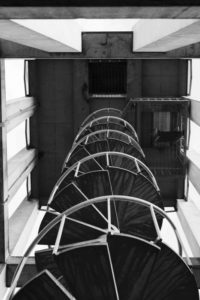In 2001, Dan Eastabrook made the winning bid on an old Fuji digital camera on eBay and started taking pictures. Twenty years later, he’s being featured in Real Life, Real Light, a solo show at Fortune Gallery.
Eastabrook is a multi-genre photographer with a penchant for landscape and urban images. He attended Victoria’s Western Academy of Photography in 2006, and again in 2009, taking both the Written Image and Advanced Visual Communications courses. Eastabrook says that the photojournalism aspect of these courses was the primary influence on his artistic style because it emphasizes true-to-life imagery rather than shots that have been altered or fabricated.
“I prefer things that are more spontaneous and real and genuine, the things that perhaps tell a story and are more natural,” he says. “I don’t like to pose, I don’t like to construct. If I’m looking at a person, I want something genuine.”
Eastabrook says that he doesn’t like to heavily Photoshop his images, because it compromises the inherent essence of the subject.

“I don’t like to do things that alter the fundamental truth of an image,” he says. “I don’t do a lot of touch-ups to things like skin and imperfections and things like that. I like to shoot people the way they are and the way they wind up in the final picture, not airbrushed—that’s just not my thing.”
This rigorous authenticity applies to inanimate subjects as well. Eastabrook acknowledges that heavily altered images of landscapes are popular, but feels that it’s simply turning the initial vistas into something fake.
“Some of them are just retouched to hell, you can look at them and think, this is not even anything close to real, and I get dismayed at that a little,” he says. “When I shoot a landscape, I try to keep it as close to what I saw as possible, and not what I think I saw, or want to see, because then you’re pushing yourself into areas like shades of green that don’t exist, or skies that just weren’t there, things like that. That genuine look is what informs all my shooting.”
Eastabrook says that he appreciates finding abstract geometric form within everyday structures, as well as contrasting light and darkness; a good example of this is his picture “Stairwell of the Centennial Carillion.”
“Concrete is really good for that sort of thing, especially when you’ve got something like the juxtaposition between the lines of the pillars and the curving lines of the staircase itself,” he says. “If it’s an artificial construct, I like to look for things like line and geometry and shape, and if it involves people I try to include them in that same thing.”
Eastabrook enjoys taking naturalistic photographs of people on the street, but says he believes it is crucially important to be respectful.
“The trick is both respect and bravery at the same time, and it’s hard to pull off,” he says. “You keep a respectful distance but you get the shot as well. You have to be respectful because you are in essence taking from someone. And you don’t necessarily have to give back, but you are taking from someone.”
Eastabrook believes that photography is important to a culture and its people, because it provides artistic value in addition to documenting history.
“Record keeping, being a witness—I think, since its inception, its creation, it’s a fundamental thing of any culture. I think that journalists and artists will always serve a purpose, I think they’re both equally important, they both serve a greater need,” he says. “With regards to a particular culture, you need something to both create art and be a witness to events, and photography can do both.”
Real Life, Real Light
Until Wednesday, April 28
Fortune Gallery
fortunegallery.ca
